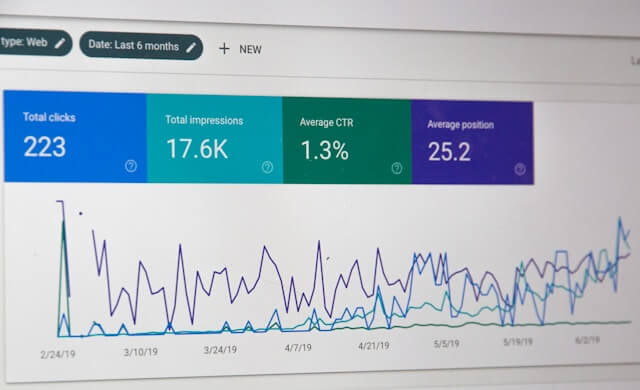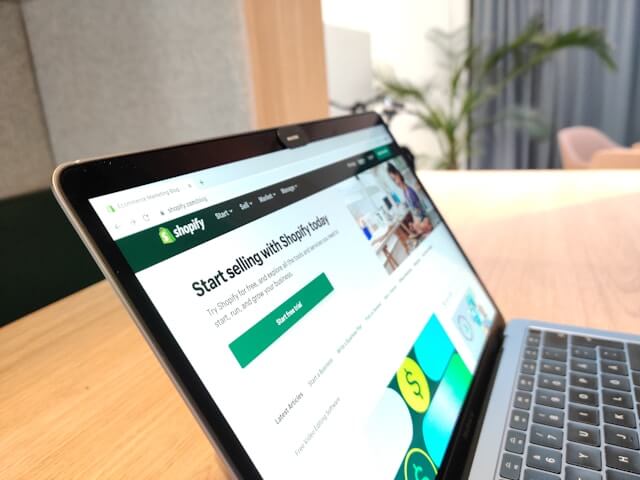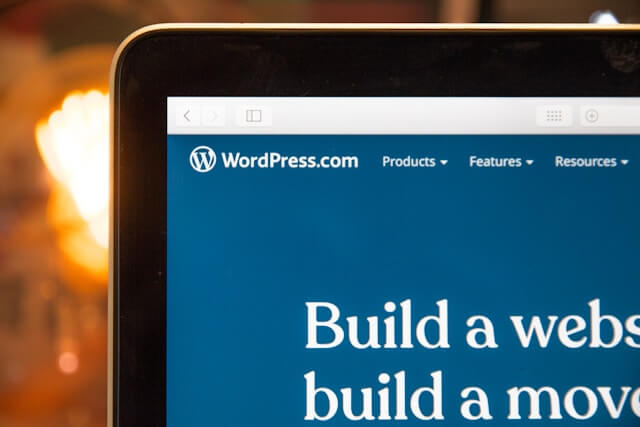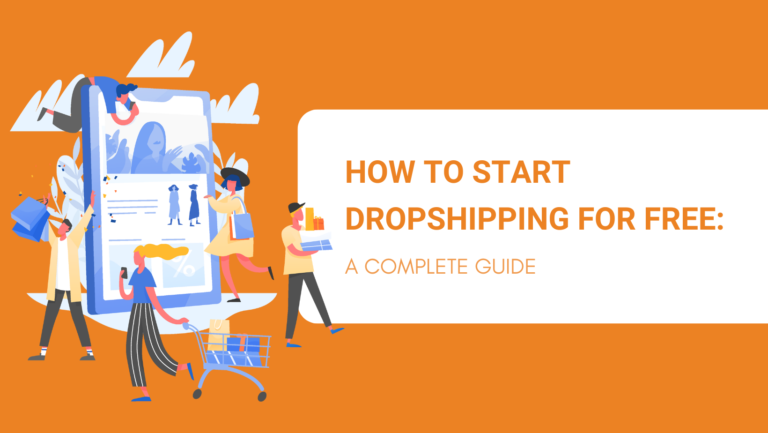Dropshipping has emerged as a popular model for entering e-commerce with minimal barriers. It involves selling products directly to customers without stocking inventory, but can you embark on this venture without any money?
The short answer is yes, with careful planning and utilization of free tools and resources.
Navigating through the world of dropshipping without an initial investment involves more than just choosing products to sell; it’s about strategic planning and smart decision-making.
Despite the challenges you might face when starting with a slim budget, this article will help to provide actionable steps to jumpstart your dropshipping journey at no cost.
You’ll discover the framework you need to follow, encompassing everything from choosing a niche and selecting the right products to developing a business plan and finding cost-effective ways to market your store.

Can You Start Dropshipping with No Money?
Starting a dropshipping business with no money might seem daunting, but it is indeed possible. You can begin by finding suppliers who offer dropshipping services for free.
Typically, these suppliers allow you to list their products without any upfront cost—you only pay once you make a sale.
To start a dropshipping business without an initial investment, consider these steps:
- Choose a Niche: Focus on a specific market or type of product that interests you.
- Free E-commerce Platforms: Utilize platforms that offer a free trial to set up an online store.
- Free Trial Perks: Many platforms include essential features like SSL certificates and hosting.
- Create Your Store: Use free design templates to create a free and professional-looking store.
In addition to the store setup, you’ll also need to promote your store. You can start free trial accounts with various advertising platforms or utilize free marketing channels such as:
- Social media
- SEO strategies
- Content marketing
Using these organic forms of promotion, you can drive traffic to your store without spending on ads.
Remember, while you can start dropshipping for free, scaling your business will eventually require reinvesting some of your profits back into it. This investment goes towards buying more stock, improving your store’s design, or investing in paid marketing.
The Pros and Cons of Dropshipping with No Money
Starting your own dropshipping business for free can be an exciting venture. You have the opportunity to create a free online store and enter the world of ecommerce without the usual startup costs. Here’s what you should consider:
Pros
- Low Financial Barrier: You can start your dropshipping journey with minimal upfront cost since you won’t need to pay for inventory. This makes it a low-risk endeavor for many aspiring entrepreneurs.
- Flexibility: Your online store can be operated from anywhere, allowing you to work on your own terms and schedule.
- Educational Value: You’ll gain valuable, transferable ecommerce skills, regardless of your future business plans.

Cons
- Supplier Limitations: With no money, you might be limited to fewer supplier options, which can affect the quality and variety of products you offer.
- Marketing Constraints: Without funds to invest in marketing, attracting customers to your store can be challenging.
- Growth Challenges: Scaling your business could be harder without cash for investment in faster shipping or branding.
How to Start Dropshipping for Free? A Step-by-Step Guide
Step 1: Choose a Niche
Identifying the right niche is crucial for starting a dropshipping business with no investment. Not only should it align with your interests but it must also have enough demand to drive sales. Here, you’ll learn to use specific tools to pinpoint a profitable niche.
Google Trends
Begin with Google Trends to gauge consumer interest over time. Look for a consistent upward trajectory or stable demand in a niche.
For instance, type “yoga mats” into Google Trends to see how often people search for this product. Seasonal spikes can also indicate potential for timed marketing strategies.
AliExpress Dropshipping Center
At the AliExpress Dropshipping Center, examine metrics like the volume of orders and ratings to identify popular products that you might include in your niche. Products with high demand and positive ratings suggest a viable niche.
For example, if wireless chargers have thousands of orders and high ratings, this could be a promising niche to consider.
Amazon Movers and Shakers
Lastly, use Amazon Movers and Shakers to discover rapidly climbing products in various categories. This list refreshes hourly and helps you spot trends before they become oversaturated.
A sudden jump in sales for ergonomic office chairs could signify a trending niche with potential for dropshipping.

Step 2: Identify Profitable Products
Selecting the right products is crucial when starting a dropshipping business without an initial investment.
Profitable products often have the following characteristics: high demand, low competition, and a good profit margin. They also solve a problem or fulfill a need.
Research Tools
- AliExpress: Here, you can find a section called ‘Dropshipping Center’ where you can discover popular items.
- Amazon: The ‘Best Sellers’ lists reveal items that are currently trending.
- eBay: Look for ‘Watch Count’ to see how many people are keeping an eye on specific products.
Begin your research by noting down potential products. Ideally, you want to find winning products to sell that are popular and less saturated in the market.
Conduct Market Analysis
- Sales Volume: High sales can indicate a winning product.
- Reviews/Ratings: Products with high ratings but fewer reviews may suggest a niche with room for competition.
Check Competitors
- Search the item on each platform and see how many other dropshippers are selling it.
- Note the range of prices the product is being sold for.
Remember to note the aspects that could make a product profitable for your store, such as adaptability and seasonality. You should also consider how shipping costs will affect your pricing strategy.
Step 3: Create a Business Plan
When you’re starting out in dropshipping without startup funds, crafting a thorough business plan is a step you cannot afford to overlook.
A business plan is your roadmap to success. It helps you navigate the competitive landscape, manage your finances, and steer your business toward growth.
Here’s a straightforward approach to put your plan together:
1. Executive Summary
Begin with a concise overview of your dropshipping business. Outline your vision, mission, and the specific niche you’re targeting. Even though you’re starting for free, having a clear purpose is vital.

2. Market Analysis
- Identify your target market and their needs.
- Research what your competitors offer (Competitive Research).
- Pinpoint what sets your store apart.
3. Marketing and Sales Strategy
- Plan how you’ll attract customers to your store. Whether through social media marketing or SEO.
- Decide the channels for promotion, keeping budget constraints in mind.
4. Operations Plan
- Outline the day-to-day operations.
- Detail the management structure, if applicable.
- Describe how orders will be processed and delivered with your chosen dropshipping supplier.
5. Financial Plan
- Project your revenue, considering the price point and expected sales volume.
- Keep a tab on expenses, even if they’re low initially.
- Plan for future investments to scale your business.
Bullet lists and tables are efficient ways to keep information clear and accessible. For example:
| Month | Expected Sales | Marketing Costs | Profit |
| 1 | 50 units | $0 | $X |
| 2 | 75 units | $20 | $Y |
| 3 | 100 units | $50 | $Z |
List the resources and tools that will help you run your business effectively, and remember, success doesn’t happen overnight. Patience and persistence paired with a solid plan are your allies in this exciting journey.
Step 4: Find Reliable Suppliers
Finding reliable suppliers is a pivotal step in launching your dropshipping business. It’s important to vet suppliers thoroughly to ensure the quality and consistency that your customers will expect.
Google Search
Initiate your search for suppliers with a simple Google search. Use specific keywords like “wholesale distributors” or “dropship suppliers for [product/niche]” to find suppliers in your niche.
It’s crucial to check the credibility of these suppliers by reading reviews and, if possible, reaching out to current customers.
Free Online Supplier Directories
Free online supplier directories offer a centralized list of suppliers that can be filtered by niche, location, or product type.
Directories like Worldwide Brands or SaleHoo can sometimes offer free access or trial periods. Make sure to verify that the information is current and that the suppliers listed have good reputations.
Trade Shows

Attending trade shows can give you a firsthand look at potential suppliers and their products. It allows you to meet with suppliers, ask questions, and build relationships.
Check the events calendar for trade shows in your industry, and remember to prepare some questions about minimum order quantities and shipping times.
Alibaba and AliExpress
Platforms such as Alibaba and AliExpress are substantial resources for finding suppliers, especially if you’re looking for overseas manufacturers.
Before placing any orders, it’s important to communicate clearly and negotiate terms. Look for suppliers with high ratings and positive feedback on their profiles.
A List of Free Dropshipping Suppliers in the USA
- Doba: Access to numerous products and a straightforward integration with your online store.
- Dropship Direct: Offers a free platform with a wholesale product library.
- Sunrise Wholesale: Integrates with eBay and Amazon with real-time inventory updates.
- National Dropshippers: Monthly membership options for access to their large catalogue of goods.
When selecting suppliers from this list, you should visit their websites and contact them to confirm they meet your specific dropshipping needs.
Be aware that “free” services may come with other costs, such as higher per-item fees, so it’s important to read the fine print.
Step 5: Choose the Right E-Commerce Platform
Selecting an appropriate e-commerce platform is a critical decision when starting your dropshipping business. The right platform can help keep your initial costs low and help you manage your online store easily.
Shopify
Shopify is a popular choice for many dropshippers due to its ease of use and dropshipping apps like Oberlo.
Although Shopify isn’t free, it does offer a 14-day free trial to set up your store and test the platform. Prices start at $29/month and increase based on your needs.

Pros
- User-friendly interface
- Multiple dropshipping apps available
- Extensive resources and a strong support community
Cons
- Monthly fees after the trial period
- Transaction fees unless using Shopify Payments
WooCommerce
WooCommerce is a free WordPress plugin that transforms a website into a fully functional e-commerce store. It’s a cost-effective solution when paired with a WordPress-hosted site.
You only pay for the hosting and any additional plugins you might need.
Pros
- Completely free to use
- Highly customizable
- Large community for support
Cons
- Requires a WordPress site
- Hosting and themes can incur additional costs
Wix
Wix is known for its intuitive drag-and-drop website builder. It offers a limited free plan with Wix branding, but you’ll need to choose a paid plan starting at $23/month for a professional store.
Pros
- Easy-to-use website builder
- Free plan available
Cons
- Less tailored for e-commerce compared to others
- Wix ads displayed on the free plan
Etsy
Etsy allows you to list dropshipped items on their marketplace, targeting customers seeking unique, handcrafted, or vintage goods. No monthly fees are required, but listing and transaction fees apply.
Pros
- Access to a large audience
- No monthly subscription fee
Cons
- Not as customizable as independent platforms
- Fees for listing and selling items
Facebook Marketplace
Facebook Marketplace is gaining traction as a platform for dropshipping. The platform is free to list items and exposes your products to a broad audience on social media.
Pros
- No startup or listing fees
- Large, engaged audience
Cons
- Limited e-commerce features
- Reliant on social media traffic
Step 6: Create a Free Dropshipping Store

Starting your dropshipping store without any investment is very possible. Using WordPress, a robust and free content management system, gives you access to a platform that powers many online stores.
Here’s how to set up your dropshipping store on WordPress:
- Sign up for WordPress: Go to WordPress.com and sign up for a free account.
- Choose a Theme: Select a free theme that is optimized for e-commerce. Your theme determines the look of your store, so pick one that suits your niche and style.
- Install WooCommerce: Navigate to plugins and install WooCommerce, a free WordPress e-commerce plugin. It allows you to sell products and services from your WordPress site. It’s simple to install and customize and will enable you to create listing pages for your products.
- Add Free Dropshipping Plugins: Consider adding plugins such as WP Dropshipping to WordPress to help source and manage inventory from suppliers, often at no upfront cost.
- Customize Your Store: Add your products, set up payment methods, and tweak your store settings through WooCommerce. Customize your store’s appearance to match your brand.
Remember, while the store’s front-end can look fantastic, the backend must be functional too. Regularly update your site to keep it secure and running smoothly.
By taking advantage of free tools like WordPress and WooCommerce, complemented by dropshipping plugins, you can have an operational online store without the immediate need for significant financial investment.
Take your time in this step to ensure that every detail reflects your brand and offers a user-friendly experience for your future customers.
Step 7: Import Your Product Listings
Once you have chosen your products, the next vital step is to import them into your online store. This might sound technical, but with the right tools, it’s a straightforward process.
Here’s how to get your product listings from your supplier onto your store’s platform efficiently:

- Select a Dropshipping Tool: Start by selecting a dropshipping tool compatible with your chosen e-commerce platform. There are free tools that can help you easily import products if you’re using Shopify.
- Connect Your Store: Next, connect this tool to your online store. This typically requires installing a plugin or app on your e-commerce platform and logging into both your store and the dropshipping tool to synchronize them.
- Choose Products: With the sync in place, you can now browse through your chosen supplier’s catalog. Look for products that align with your niche and balance demand, quality, and affordability.
- Import With Customization: The beauty of dropshipping tools is that they let you import products directly to your store. Customize product details such as titles, descriptions, images, and prices to make them unique to your brand.
- Price Your Products: Set your retail prices. Remember the cost of goods and include a markup for profit. Also, consider your competitors’ pricing to remain competitive.
- Organize into Collections: Group your products into collections or categories to make it easier for customers to find what they want. This organization can enhance the shopping experience and increase sales.
- Review and Edit: Before going live, review your listings. Check for errors in descriptions, low-quality images, and uncompetitive prices.
By following these steps, you can effectively list products in your store without any cost. This process is crucial to ensure your store reflects your brand and provides a seamless shopping experience for your customers.
Step 8: Market and Promote Your Products
Once you’ve set up your dropshipping store, it’s crucial to attract customers. Marketing and promotions are the lifelines that will draw the audience to your products.

1. Choose the Right Platforms: Not all social media platforms are suitable for every business. You should select platforms where your potential customers are most active.
For example, if you’re targeting a younger audience, Instagram and TikTok can be powerful tools for showcasing your products.
2. Leverage Influencers: Collaborating with influencers can significantly boost your business. Influencers have established audiences and can engage potential buyers by introducing your brand to them.
Often, they’re willing to work in exchange for free products or shared revenue.
Email Marketing
1. Build a Subscriber List: Start collecting emails from day one. Use your website, blog, and social profiles to encourage sign-ups with the promise of value, such as exclusive deals or content.
2. Send Targeted Campaigns: Send regular newsletters and promotions. Every email should offer value to your subscribers, whether it’s a discount code, informative content, or updates on new arrivals.
Content Marketing
1. Create Valuable Content: Generate interesting and helpful content that resonates with your audience. Whether through blog posts, videos, or infographics, providing value can improve your SEO and drive traffic to your store.
2. Optimize Content for Search Engines: Use relevant keywords and SEO best practices to make sure your content is easily discoverable. High-quality, SEO-friendly content can attract organic traffic without any financial investment.
Step 9: Place an Order to Your Supplier
Once you’ve secured a sale, it’s time to fulfill your customer’s order. Your supplier is the key to ensuring customer satisfaction, so here’s how to navigate this crucial step efficiently.
Review the Order
Before sending anything to your supplier, double-check the order details — the product, quantity, and the buyer’s shipping information. Accuracy here prevents any issues down the road.

Place Your Order
Reach out to your dropshipping supplier through your agreed-upon method — be it their online platform, email, or a direct integration with your store’s system. Input all the necessary details accurately and confirm the purchase.
- Order Notification: Send a notification to your supplier for the item, which can be automated through most dropshipping platforms.
- Shipping Details: Provide the shipping address that your customer entered at checkout.
- Order Confirmation: Wait for confirmation from your supplier that they’ve received the order and are processing it.
Communicate with Your Customer
Let your customer know their order is on its way. Communication is key, as it can increase buyer satisfaction and reduce anxiety about delivery times.
Always confirm inventory availability and be clear about the expected shipping times. Remember that some suppliers offering free dropshipping services may take longer to ship. It’s essential to manage expectations both on your end and with your customer.
Keep a record of the purchase order and transaction as a reference for tracking and accounting purposes. Should an issue arise, you will need these details to resolve it quickly.
Step 10: Follow Up and Stay Available
After your dropshipping store is up and running, your job isn’t over. It’s vital to stay engaged with your customers and offer excellent post-purchase support.
Here are a few tips to ensure you stay on top of this critical step:
- Send Order Confirmations: Send an email confirming the order after a purchase. This shows reliability.
- Offer Transparent Shipping Updates: Keep your customers informed about their order status. If using a platform like Shopify, utilize the built-in features or plugins to automate this process.
- Encourage Feedback: Ask for reviews or ratings of the product and the shopping experience. This can guide improvements and build customer trust.
- Provide a Clear Return Policy: Have an easy-to-understand return policy to help customers feel secure in their purchases.
- Be Prompt in Communication: Respond to inquiries and address issues quickly. Aim to solve problems within 24 hours.

Customer Support Tools:
- Live Chat: Add a live chat option to your store. Many customers prefer a quick chat over email or phone calls.
- FAQ Page: Create a detailed FAQ page to help answer common questions and reduce customer inquiries.
- Social Media: Be active on social media platforms to engage with your customers quickly.
Remember, being available for your customers can lead to repeat business and referrals. It shows you value their satisfaction, which is a cornerstone of a successful dropshipping business.
Tips for Growing Your Dropshipping Business with No Money
- Identify Winning Products: Focus on products with high demand and low competition. Use tools like Google Trends to track trending items you can sell online.
- Leverage Free Online Platforms: Create your store on platforms that offer free startup options. Social media marketplaces and free e-commerce website builders can help you establish your presence without an initial investment.
- Optimize for Search Engines: Implement search engine optimization (SEO) on your product pages to increase visibility. Use relevant keywords that potential customers might use when searching for your products.
- Utilize Social Media Marketing: Build a strong brand presence on social media platforms. Engage with your audience and create shareable content that can organically spread.
- Offer Exceptional Customer Service: Providing timely and helpful responses can lead to positive reviews and repeat business. Strong customer service is often shared online, leading to free word-of-mouth promotion.
- Implement Cost-Effective Advertising: Use low-budget advertising options such as pay-per-click ads, or take advantage of Facebook’s shop feature, which allows you to sell directly on your page.
- Analyze Your Performance: Regularly review your analytics to understand what works and what doesn’t. Use this data to refine your strategy and focus on high-performing areas.
4 Alternatives to Free Dropshipping
Starting a dropshipping business without investment can be challenging, but there are business models that can serve as alternatives to traditional dropshipping. These options have low barriers to entry and can be lucrative if you have the right strategy.

Affiliate Marketing
Affiliate marketing allows you to promote products and earn a commission for each sale made through your referral link. Unlike dropshipping, you don’t have to deal with inventory or customer service.
Amazon, for example, offers an affiliate program where you can select products to sell and earn up to 10% in commissions. This program is a good starting point for beginners.
Digital Products and Services
Selling digital products is a powerful alternative because you can create and label products for free or at a minimal cost. E-books, courses, music, or digital art can all be sold indefinitely without restocking.
Platforms like Etsy let you list digital services, turning your expertise into a profitable business without the need for physical suppliers.
Print on Demand
Print on demand (POD) is a business model in which you partner with a supplier to customize white-label products with your designs and sell them on a per-order basis. This approach eliminates the need for inventory management.
With POD, you can offer a variety of items such as t-shirts and mugs without initial investment, leveraging companies like Printful to handle the production.
Drop Servicing
Drop servicing, also known as service arbitrage, involves selling services that a third party fulfills. You act as the middleman managing client relationships and customer service, while your freelancers or partners complete the service.
For example, you can offer SEO or graphic design services and outsource the work to skilled individuals while you focus on acquiring clients.
Frequently Asked Questions
Embarking on a dropshipping venture without initial funds is quite possible. This section answers some of the most common questions related to starting and running a dropshipping business with no financial investment.
Are There Some Good Free Dropshipping Courses or Guides?
If you’re a beginner in the dropshipping industry, you’ll need to do your research and keep up with the latest changes.
To learn the basics of free dropshipping, you can check out the Dropshipping 101 blog on the NicheDropshipping website.
You can find some other good free dropshipping courses on Udemy. Another good idea is to look everything up on YouTube. There, you can find all types of beginner guides and tutorials on free dropshipping.
How to Drop Ship for Free with AliExpress?
There’s a good reason why AliExpress is the number one eCommerce marketplace of choice for fresh drop shippers. As a B2C marketplace, AliExpress doesn’t have high MOQs, which means you can ship individual orders.
Most AliExpress sellers and suppliers will have no problem shipping to your end-consumer and merely removing the invoice from the package (or even place your own instead).
As a buyer, AliExpress is entirely free to sign up, use, and buy from. Of course, some products will have free shipping to your customers while others won’t.
How to Offer Free Shipping If You Dropship with No Money?
What if you want to start dropshipping for free but can’t find a product with free shipping? How can you offer free shipping to customers without spending money upfront?
To solve this, drop shippers usually add the shipping price to the base price of the product so that they can offer free shipping to end-consumers.
That means that you’ll sell your product slightly more expensive to be able to cover the shipping cost that you’ll inevitably pay.
Like this, you can make your product more attractive by offering free shipping.
Can I Dropship Private Label or White Label Products for Free?
Dropshipping a private label product entails having it first produced with your label. Regardless if a drop shipper or a manufacturer will help you private label the product, it’s always going to have a higher MOQ.
The high MOQ for private label products is because an entire production line must run to manufacture your product precisely as you want.
In the case of white labeling, when you’re just adding your custom packaging, invoice or tags, you might have a lower MOQ, but you’ll still need to order more than one product.
Considering all that, it’s easy to see why it’s so tricky to dropship private label or white label products for free.
On top of that, to private-label a product and have a one-product store, you have first to ensure that the product will sell. Otherwise, you’re risking losing your entire upfront investment for production and purchasing the products from the manufacturer.
And if all of that’s not enough, bulk orders also mean inventory storage costs, which is not something you want as a beginner.
The best thing you can do if you’re new to the dropshipping industry is to start free dropshipping from AliExpress or similar free websites and leave private labeling for later when you’re ready to scale.
Can a Dropshipping Agent Help Me Find Free Dropshipping Suppliers?
Yes. A dropshipping agent or a good product sourcing agent should be able to help you find dropshipping suppliers on free websites or marketplaces.
For example, NicheDropshipping is a well-known product sourcing and dropshipping agent in China that sources products from 1688, Taobao, etc.
Various agents in China might specialize in different product niches, so get in touch and ask everything you want to know before agreeing to collaborate.
Another thing to ask your dropshipping agent is where they have warehouses or fulfillment centers. Collaborating with a dropshipping agent with warehouses in the US will immensely shorten shipping times.
Final Takeaways: Launching Your Dropshipping Business for Free
Embarking on your dropshipping journey without an initial investment is certainly possible, proving to be both an insightful and practical approach to ecommerce.
To begin, prioritize educational resources. A clear understanding of dropshipping mechanics is a must, so invest time in learning before diving in.
Finding the right dropshipping suppliers is crucial. Seek those offering a sourcing request, as they can help you access products without upfront costs.
Additionally, choose a free e-commerce platform that aligns with your business model. Platforms like Shopify provide a user-friendly experience, essential for new entrepreneurs.
When setting up your online store, focus on creating detailed product descriptions and high-quality images to attract and retain customers. Strong marketing strategies are vital; utilize free channels like SEO or social media to promote your store effectively.
Remember, while launching with no money is feasible, growth may be slow, and scaling your business could require future investment. Harness your resourcefulness and creativity to stand out in a crowded marketplace.
Stay dedicated, and when you’re ready to scale, consider reaching out for a free sourcing quote. This is where your journey evolves from a free starting point to a thriving dropshipping business.


I’m now not certain the place you’re getting your info, but great topic. I needs to spend a while finding out more or understanding more. Thanks for great info I was in search of this info for my mission.|
Thank you for such useful information much appreciated